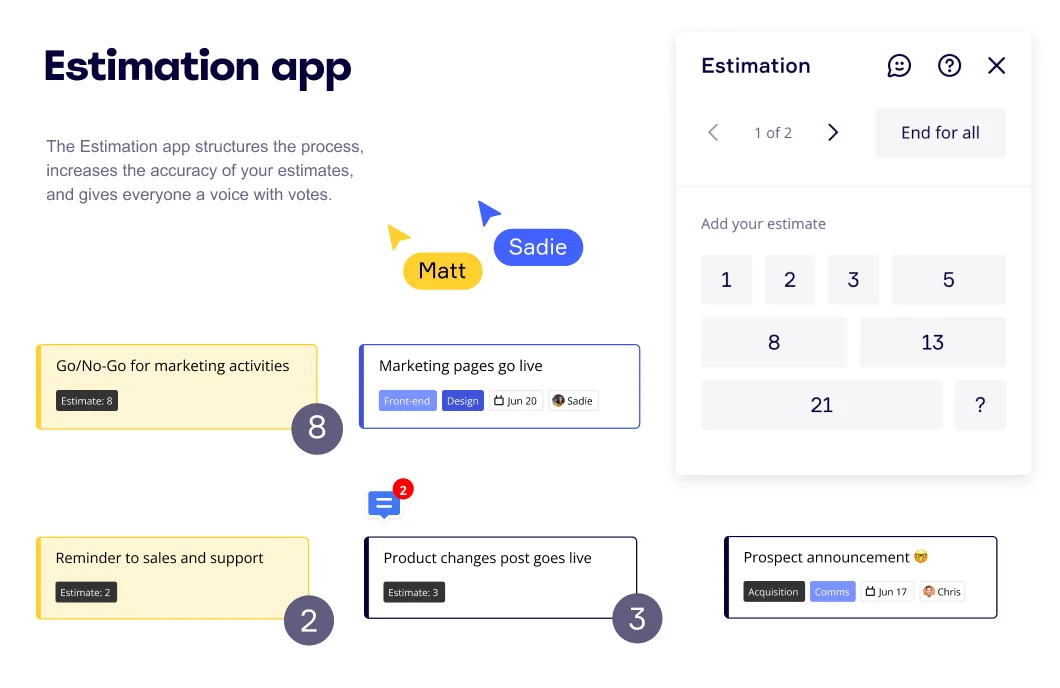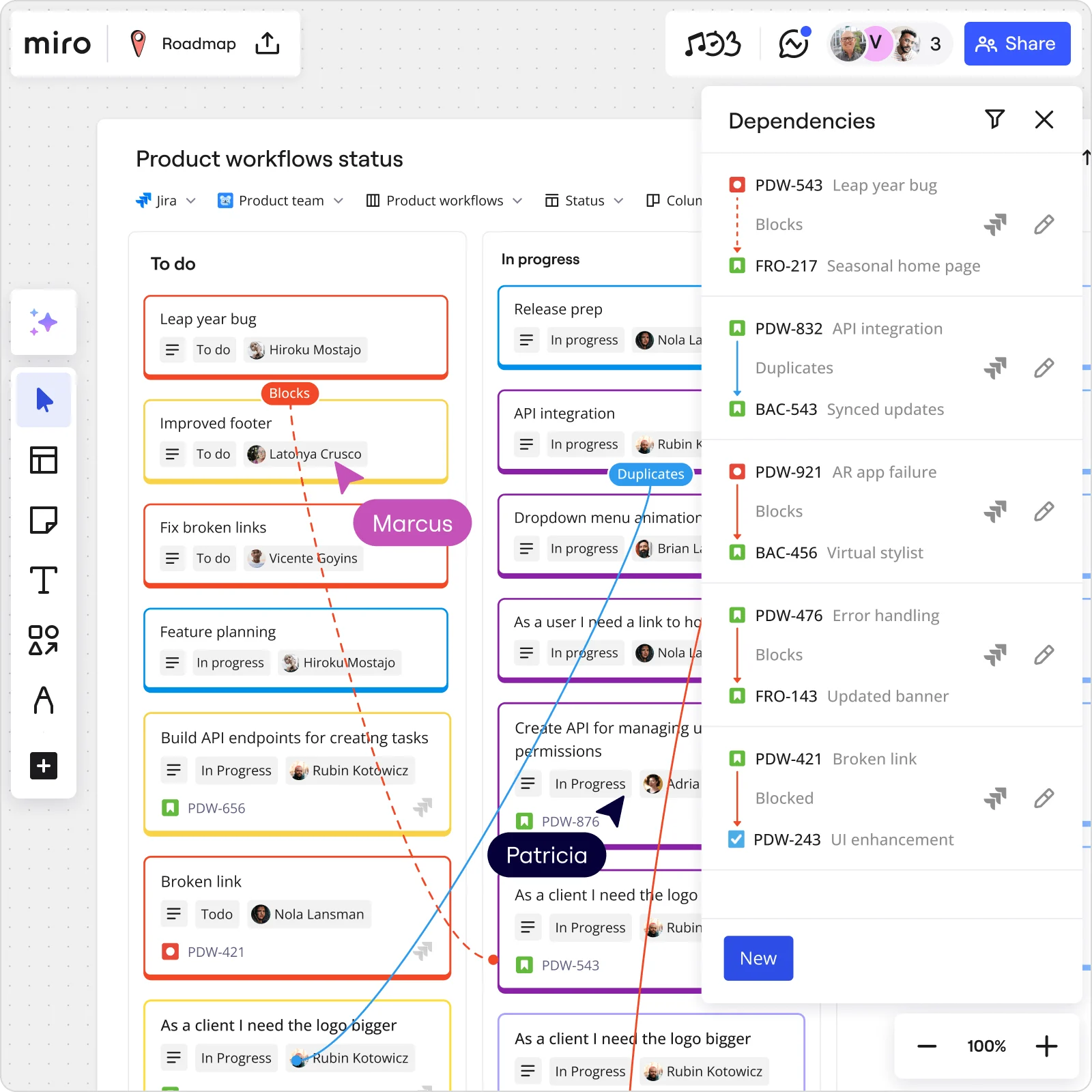
Table of contents
Table of contents
Story points — what Agile teams need to know

Summary
In this guide, you will learn:
- What story points are: abstract units in Agile for estimating task effort.
- Why story points are preferred: reduce bias, account for non-project work, focus on problem-solving.
- How story points help: prioritize work, plan sprints, improve estimation accuracy.
- Factors influencing story point estimation: volume, complexity, risks, unknowns.
- Common challenges/best practices: avoid misuse for productivity judgment or detailed timelines.
- How story points contribute: measure team velocity for better forecasting and continuous improvement.
Try Miro now
Join thousands of teams using Miro to do their best work yet.
Story points are a unit of measure for expressing the overall effort required to implement a user story. They reflect the complexity, uncertainty, and risk associated with a task, rather than just the time it will take to complete.
In this guide, we'll dive into the meaning of story points, their role in agile methodologies, and how to estimate them effectively.
Whether you're part of a product development team, an agile team, or a design & UX team, this guide will provide valuable insights to improve your story point estimation skills. Let's get started.
What are story points in Agile?
Story points are a cornerstone of Agile project management. They measure the effort required to complete a user story, emphasizing complexity over time.
Unlike time-based estimates, story points focus on relative sizing. This approach encourages teams to think about effort and challenge rather than hours.
Key aspects of story points:
To better understand how story points work, let's take a closer look at what they aim to do:
- Measure effort, not time
- Focus on complexity, risk, and uncertainty
- Encourage team discussion and consensus
Story points help teams align on what it takes to deliver a feature. They also foster collaboration and ensure a shared understanding of project scope.
Benefits of story points in product development
Using story points come with plenty of advantages for improving team productivity — specifically:
- Prioritize tasks by complexity
- Support consistent workload estimation
- Facilitate sprint planning and roadmapping
Overall, story points help create realistic expectations and timelines, ensuring smoother project execution. They also enhance communication among stakeholders by providing a common language for discussing workloads.

Story points in product development
Story points play a vital role in product development by helping teams prioritize and manage their backlog. They provide a framework for comparing different tasks' complexity and effort, which aids in planning and decision-making.
Using story points allows product teams to maintain a consistent approach to estimating work. This consistency supports clear roadmapping and forecasting.
Story points vs. time-based estimates
Story points focus on the effort and complexity of a task, rather than the time it takes to complete. This approach helps Agile teams better account for uncertainties and complexities in their projects. Unlike time-based estimates, story points encourage teams to think in terms of relative effort, reducing pressure and improving accuracy.
Time-based estimates, while straightforward, can lead to unrealistic expectations. They often fail to account for potential blockers or variations in team productivity. Story points foster a more flexible planning approach, allowing for adjustments as project dynamics change. This difference empowers teams to tackle challenges with a realistic perspective.
Common pitfalls to avoid when estimating
Estimating story points accurately can be tricky. Teams often face issues that skew their estimates and derail productivity. Recognizing these common pitfalls helps you sidestep potential mistakes.
Here's how to avoid them:
- Overcomplicating Estimations: Keep it simple. Focus on relative sizes.
- Ignoring Team Differences: Consider each team member’s experience level.
- Underestimating Complexity: Be realistic about task intricacies.
By staying aware of these pitfalls, you can refine your estimation practices. Use Miro to facilitate transparent discussions, ensuring everyone shares a common understanding. Promote open dialogue and regularly revisit your estimation process for continuous improvement.
Story points for sprint planning and roadmapping
Story points can streamline sprint planning and product roadmapping efforts. They offer a reliable way to estimate work and allocate resources efficiently. With story points, teams can prioritize tasks and plan sprints that align with capacity.
Here's how you can use them:
- Identify high-priority features using story point estimates.
- Align project timelines based on story point distribution.
- Adjust sprint goals to match team velocity.
Leverage Miro’s innovation workspace to visualize and track these points. This helps teams stay aligned and focus on delivering value consistently. By integrating story points into planning, teams can ensure smoother execution and better project outcomes.
Story points estimation for remote and async work
Remote work presents unique challenges for story point estimation. Teams can overcome these hurdles by embracing async communication tools. Miro's collaboration features support this transition seamlessly.
To adapt estimation sessions for remote or async environments:
- Schedule virtual meetings using Miro's video conferencing tools.
- Use digital sticky notes for brainstorming in real-time.
- Employ voting features to reach consensus asynchronously.
These strategies ensure that everyone contributes effectively despite geographical distances. Miro keeps team members connected and informed, enabling smooth workflows. By adapting to these techniques, teams can maintain precision and productivity, regardless of their physical locations.

Continuous improvement
Continuous improvement is key to mastering story point estimation. Regularly review and analyze past projects to identify areas for enhancement. Encourage team feedback to uncover potential adjustments. Leveraging Miro's data insights and visualization tools can further refine accuracy and consistency, ensuring your process evolves alongside team growth and project demands.
Example of a story point estimation in practice
Imagine your Agile team is tasked with adding a new login feature to your application. To estimate the story points, the team first discusses the complexity, potential risks, and uncertainties involved. They consider factors like integrating with an existing authentication system, designing the user interface, and ensuring security measures. After a thorough discussion, the team agrees that this task is relatively straightforward but has some moderate complexity due to security concerns, assigning it 5 story points.
Next, the team evaluates another task: implementing a new search functionality that includes advanced filtering options. This task involves more complexity, as it requires backend changes, a new user interface, and extensive testing to ensure accuracy and performance. Given the higher complexity and potential risks, the team assigns this task 13 story points. By comparing these tasks, the team can better understand the relative effort required and plan their sprints more effectively, ensuring a balanced workload and realistic timelines.
Using story points in this way helps the team focus on the effort and complexity of tasks rather than just the time it will take. This approach fosters better collaboration and understanding among team members, leading to more accurate and reliable project planning.
Facilitate story points estimation sessions with Miro
Facilitating a story point estimation session requires preparation and clear communication. Miro's strong collaboration features make these sessions productive and engaging. Before starting, ensure all team members understand story points basics and the chosen scale. Create a structured agenda with time for discussions and consensus-building.
Here's a guide to running a smooth session:
- Begin with a brief overview of the story points system.
- Encourage open dialogue about task complexities.
- Use Miro’s voting feature to gauge initial estimates.
Miro supports both real-time and async discussions, accommodating various team dynamics. This flexibility lets everyone participate, regardless of location or schedule. Fostering an environment of openness and collaboration helps your team reach consensus and refine their estimates effectively.
Sign up to get started.
Author: Miro Team
Last update: October 2, 2025